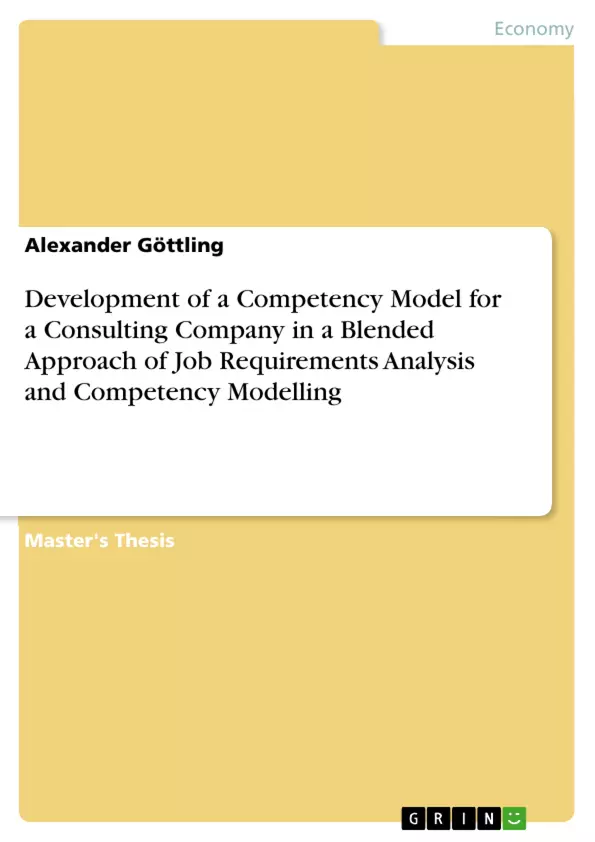Research shows that high-performing people are critical for high-performing organisations. Especially for professional service firms, such as management consultancies, people can be seen as the critical success factor. The competencies of their employees assure the long-term competitiveness of consulting firms. Thus, recruiting and selection as well as personnel devel-opment are strategically crucial for consulting firms. In other words: a strategic competency management, which is based on critical-to-success criteria, have to be in focus within this in-dustry. But how can be distinguished between high-performing and non-high-performing peo-ple? What characterises a successful consultant? What are knowledge, skills, and abilities, which determine job performance within the consulting industry? The research paper at hand tries to answer these questions with the help of a concrete example.
Over the last decades two mainstreams to answer this type of practical as well as scientifically relevant questions emerged: the requirements analysis approach, which is more quantitative and focuses on task related requirements, and the competency modelling approach, which is more related to individual characteristics and which attempts to describe how the tasks are mastered. With a blended approach, this study tries to integrate the advantages of both and to identify, what are typical tasks of consultants, which behaviour differentiates high-performing from less successful consultants, which competencies enable high-performing job holders, and which requirements can be derived from that?
In the first instance a preliminary study in a European consulting firm aims to explore thy typi-cal duties and tasks at each of five career levels using the Critical Incident Technique according to Flanagan. Then, a survey amongst all job holders in this consulting firm shall reassess the findings of the preliminary study. Finally a scientifically substantiated and at the same time implementable model with competency profiles for each career level is drawn, whilst limita-tions of this approach and further recommendations for implementation are shown.
Table of Contents
- Introduction
- Definition of the company's problem
- Aims and objectives of the research project
- Literature Review
- Job Requirements in Management Consultancies
- Requirements Analysis
- Definitions
- Methods, Tools, and Practical Application
- Quality Criteria
- Competency Modelling
- Definitions
- Methods, Tools, and Practical Application
- Quality Criteria
- Integration in a Blended Approach
- Project Report
- Purpose of the Study
- Methods of Research
- Preliminary Study
- Participants and Execution
- Interview Guidelines
- Data Analysis
- Results of the Preliminary Study
- Quantitative Analysis: Employee Survey
- Participants and Execution
- Survey Questionnaire
- Data Analysis and Results
- Recommendations and Solutions
- Critical Reflection
- Reflection and Critical Analysis of the Research Process
- Limitations
- Ethical Issues
- Results in Context of Literature Review
Objectives and Key Themes
This dissertation aims to develop a competency model for a consulting company by integrating two established approaches: requirements analysis and competency modelling. It seeks to understand the typical tasks of consultants at different career levels, identify the behaviors and competencies that differentiate high-performing consultants, and derive specific requirements for different roles within the consulting firm.
- Identifying the critical tasks and requirements for different career levels in a consulting firm
- Exploring the competencies and behaviors that contribute to successful performance in consulting roles
- Developing a comprehensive competency model that integrates both requirements analysis and competency modelling methodologies
- Evaluating the effectiveness of the developed model in predicting and enhancing consulting performance
- Providing practical recommendations for implementing the competency model within the consulting firm
Chapter Summaries
- Introduction: This chapter introduces the research problem, outlining the importance of competency management within consulting firms and highlighting the need for a robust model that integrates different approaches. The chapter defines the scope and objectives of the research project.
- Literature Review: This chapter presents a comprehensive overview of the literature on job requirements analysis and competency modelling, including definitions, methods, tools, and practical applications of both approaches. It discusses the strengths and weaknesses of each method and explores the potential benefits of integrating them within a blended approach.
- Project Report: This chapter describes the research methodology and findings. It outlines the preliminary study, which involved conducting Critical Incident Technique interviews with consultants at different career levels, and the quantitative analysis of employee survey data. This chapter also presents the findings from both research phases.
- Critical Reflection: This chapter reflects on the research process, discussing the limitations of the study, ethical considerations, and the implications of the findings in the context of the literature review. It concludes with a discussion of potential future research directions.
Keywords
The key focus areas of this dissertation are competency modelling, requirements analysis, consulting industry, job performance, career levels, critical incident technique, employee surveys, and blended approach. The research seeks to develop a competency model that integrates these diverse elements to understand and predict successful performance within the consulting industry.
- Quote paper
- Alexander Göttling (Author), 2010, Development of a Competency Model for a Consulting Company in a Blended Approach of Job Requirements Analysis and Competency Modelling, Munich, GRIN Verlag, https://www.grin.com/document/377542



